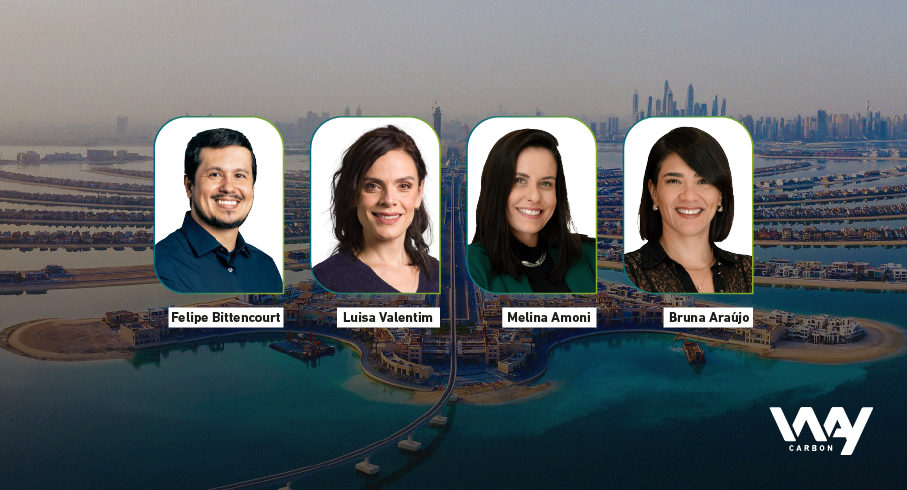Carbon credits: from generation to negotiation
On June 4th, Breno Rates (Director of Carbon Projects), Daniel Nogueira (Carbon Business Manager) and Letícia Gavioli (Sustainability Consultant), from WayCarbon, taught the workshop “Carbon Credits: from generation to negotiation”. The course was held in a partnership between WayCarbon and Capital Reset, mediated by Vanessa Adachi, founder and editor of the journal. WayCarbon shares some insights from this class below.
What is the role of carbon credits in Net-Zero commitments?
Based on evidence compiled by the Intergovernmental Panel on Climate Change (IPCC), it is possible to observe that human actions are mainly responsible for the increase in the concentration of greenhouse gases (GHG) in the atmosphere and, consequently, for the intensification of global warming. This increase in temperature causes a series of negative effects for humans, ecosystems and other forms of life on the planet. From an economic point of view, data from the Boston Consulting Group demonstrate that if global warming is not controlled it could result in a reduction of up to 30% in world GDP.
To protect the climate system, companies and governments need to make decarbonization commitments and carry out a series of technological and operational transformations, as well as financial investments. The most mature way to commit to the climate agenda today is to have a Net-Zero target approved by the SBTi (Science Based Targets Initiative), explained Breno Rates. “Reducing emissions is a difficult mission, so, even if the homework is done efficiently by companies, SBTi recommends that we also act on emissions beyond value chains. So carbon credits come into play as part of the solution to the global climate crisis,” he said.
How do they work?
A carbon project seeks to reduce or remove GHG emissions from the atmosphere. The initiative begins with a change in the way of carrying out a certain activity, compared to the way the market or society usually does it.
The carbon credit is a market instrument that aims to reward agents responsible for projects using certificates issued through registration programs. “They are important instruments for capturing resources and enabling the transition to a low-carbon economy in a faster and more cost-efficient way”, points out Rates.
How long does a project take to generate credit?
Project maturation time varies according to the chosen registration and issuance program, but an estimate made by WayCarbon shows that it takes between 12 and 24 months, on average, for a project to be conceived and generate the first credits. Some factors affect this timeline, such as the complexity of the projects and the availability of agents that need to be hired throughout the process.
What activities can generate carbon credits?
The voluntary carbon market, a category currently applied to Brazil, involves instruments that were designed outside of any compulsory system and uses independent platforms to sell credits.
In this market, it is possible to generate reduction or removal credits in different ways, such as sustainable agricultural management, reforestation, avoided deforestation, waste treatment, reduction of methane emissions in livestock farming, among others.
What are the main requirements for a project to generate credits?
For a project to generate credits in the voluntary market, it needs to take into account four main criteria: additionality, regulatory issues, compliance with the standard and methodological adequacy. Understand the points below:
1. Compliance with the standard
It is important to understand whether the activity to be implemented is accepted by the registration program (standard) of interest. For example, the VCS (Verra’s Verified Carbon Standard) and the Gold Standard no longer accept the registration of Renewable Energy projects in developed countries or with a mostly renewable energy matrix, as is the case in Brazil, as it understands that in these countries this type of initiative does not depend on the financial incentives of the projects to exist.
2. Methodological adequacy
Next, it is important to understand which available methodology the project adheres to, paying attention to the established applicability criteria, which sometimes bring limitations due to the size of the project. It is by establishing the methodology that it is possible to adequately determine the GHG reduction/removal potential of a project.
3. Regulatory Issues
The activity must be implemented voluntarily, that is, it cannot be the result of complying with any regulation. Otherwise, the project will not be considered additional.
4. Additionality
Being additional means that the GHG emissions reductions and removals associated with a carbon credit would not have occurred without the incentives or resources provided by the project. “It is necessary to prove that the income obtained through credit is in fact necessary. The less additional a project is, the less value the credit generated will have”, explained Daniel Nogueira.
How many carbon projects are there in the world?
According to 2024 data from Trove Research, there are 200 carbon projects registered in Brazil, with 119.1 million credits generated. Initiatives related to fugitive emissions and waste management are concentrated in the South and Southeast, while avoided deforestation projects (REDD+) are concentrated in the North of the country.
In the last two years, there has been an increase in voluntary projects in Brazil, however, these initiatives were already more mature in other places in the world such as the United States, Australia and China. “When we talk about the global context, there are 7,546 projects developed and 2 billion credits generated”, analyzes Nogueira.

 EN
EN  ES
ES PT
PT


